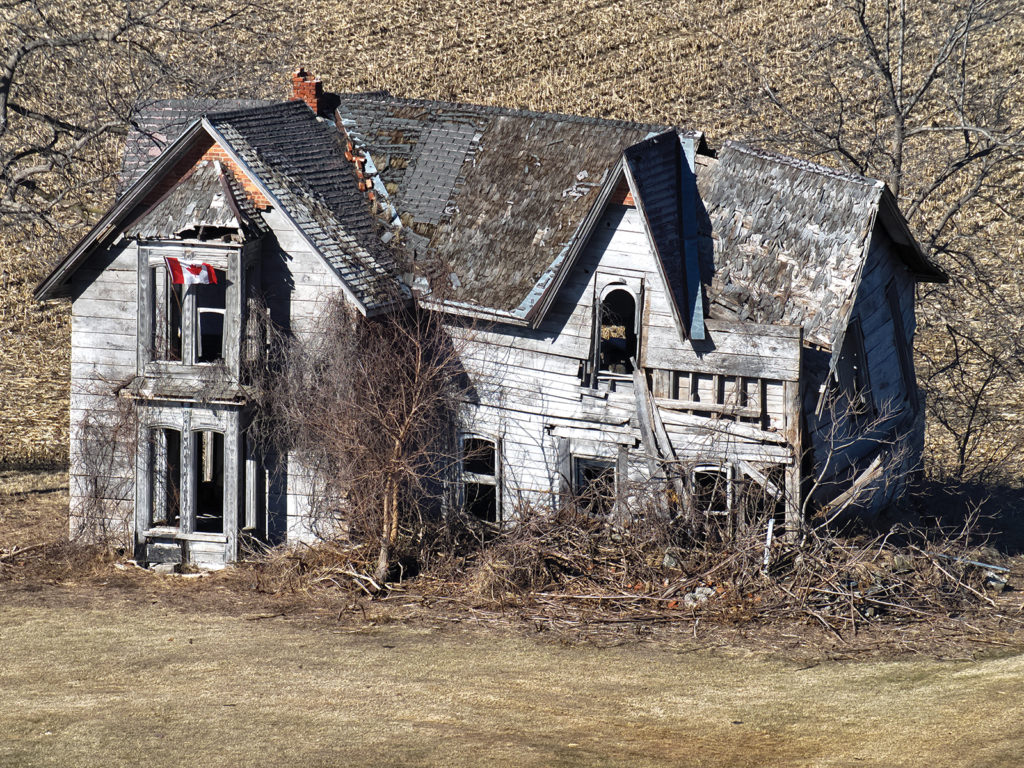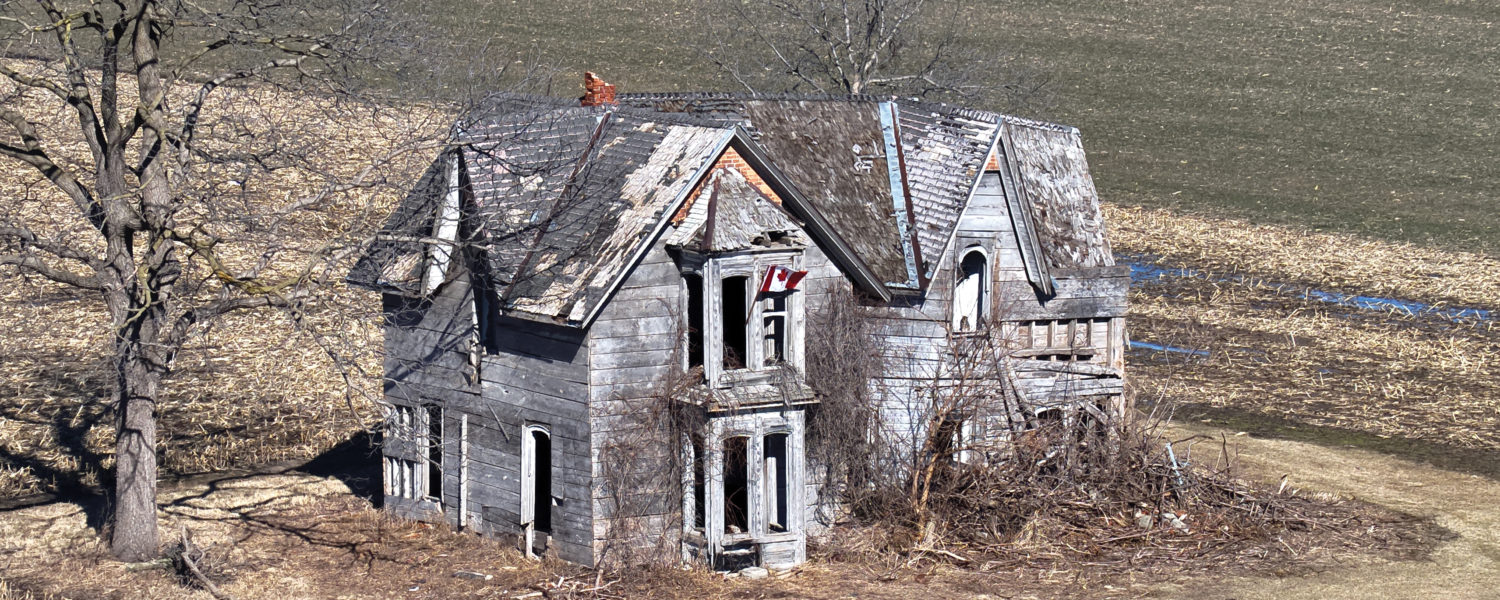For All The Architectural Excellence
In The Region, The “Most Photographed House
In Canada” is a Dilapidated Structure Built Almost
Two Hundred Years Ago
Story by Matthew St. Amand
Photography Courtesy of Windsor Aerial Drone Photography
To paraphrase the old saying: Time and tide wait for no one. Nowhere is this truer than at the Guyitt house, known as “Canada’s most photographed house,” located on Talbot Trail in Palmyra. Built sometime in the 1840s, the house is currently owned by Peter Anderson whose grandparents, Roy and Ethel Guyitt, bought the home in 1908. The house has been vacant since 1985.
Now, the race between the elements and the Chatham-Kent municipality is on. One way or another, the house is coming down. The question is when that will happen.
On August 15, 2022, Chatham-Kent’s Chief Building Official Paul Lacina received a complaint about the home’s structural safety. This set the gears of government in motion. According to an autumn 2022 article, the Municipality of Chatham-Kent sent a letter to Peter Anderson notifying him under the property standards bylaw that he had fourteen days to either fix the Guyitt House or tear it down due of these safety concerns. Peter appealed the order, a reprieve was granted, and an appeal hearing scheduled for some time this Spring.

For more than 180 years, the Guyitt House has weathered the vicissitudes of the region as a farmhouse, family home, as just another structure along a far-flung country road. As the elements took their toll, over the decades its identity as a structure from another time drew attention. Changes to the house occurred slowly. It was bricked and had a wrap-around porch until 2008. The structure has slowly slanted over time, the roof of the back bedroom eventually caved in. The roof of the main structure is canted. As the structure decayed, it ceased being a viable dwelling and became something else: a beautiful, fascinating landmark.
Not everyone sees it that way. Some see it as a dangerous structure and want it demolished.
Speaking to local media, Peter Anderson said that the house is beyond repair. He tends the lawn and enjoys how other people appreciate the property. He said visitors are welcome to take photos, but they should not enter the building.
“I left it there for one reason so that people can appreciate the historical value of Talbot Trail,” he said, speaking to local media.
There are plenty of people who appreciate it.
A local man, Mike Chase, owner of Windsor Aerial Drone Photography, is a photographer who recently discovered this local treasure.
“I do drone videography and a client had hired me to do some aerial photos a few miles past the Guyitt house,” Mike explains. “As I drove by and saw the place, and looked around online, found articles about it, it blew me away. I did a Facebook post on the house that was looked at over a thousand times. Even sitting there, at the house, photographing it with the drone, a few people stopped to photograph the house—in February!”
Mike adds: “Even when I took the pictures. It doesn’t even look real.”
As a person with a newfound interest in the Guyitt House, Mike doesn’t know anything more about the progress of it receiving protective heritage status. “I don’t know where it stands,” he says. “I have Google alerts to see if a demolition order hits the media. If that happens, I’ll go and film it that day.”
A petition was created by local man, Ken Bell, on Change.org, which states “At 5,000 signatures, this petition is more likely to get picked up by local news!” At the time of this writing, 3,732 people have signed the petition.
Amid the comments on the petition, neighbours and local people have chimed in with their thoughts about the Guyitt House, and the rightness or wrongness of the municipality demolishing it due to “safety concerns.”
One person commented, in part: “She continues to stand. She was once part of a loving home with a carriage house, barn and silo. A large, covered porch to relax on. A wood burning stove to keep away the chill. A piano to bring joy. Hedges lined her semicircular driveway. Trees protected her western face and gave fruit to smiling children. Farm life flourished. Time has erased her grandeur, yet she alone continues to stand. The weather, the flora, the fauna and people have eaten away at her over the years. And through those years her beauty has changed… Let her beauty continue to be seen while she still has the will to stand.”
Another commenter wrote: “Because old things can be beautiful too!”
Peter Anderson has told reporters: “The house is way beyond repair. That’s what adds to its historical value. There are people out there who would like to get the woodwork in the boards, the door frames, trim and everything inside that house. It stood the test of time this far. How much longer will it last?”
In a perfect world, he says, the house should be left untouched until the day it hits the ground by its own natural course. As of this writing, Peter confirms that there is no word on the progress of his appeal.
Veteran urban explorer, Dave from Freaktography.com, has visited the Guyitt House numerous times.
“It’s so eye-catching,” he says. “No wonder so many people will pull over who don’t even have an interest in abandoned photography. The weathered, exposed wood, the slanting roof.”
As to why the Guyitt House draws so many photographers, Dave observes: “What’s great about it is that there is nothing around it. The house is totally isolated, so you can stand on any side, and on a great blue-sky day, you can get some great colours with the green grass, blue sky, and the contrast of this decaying house.”
Regardless of the glad tidings or skeptical bureaucratic attention cast upon the Guyitt House, the days of this unusual landmark are numbered. Anyone in the area who has an interest in such things should set some time aside to make a visit. Time and tide wait for no one.




Add comment